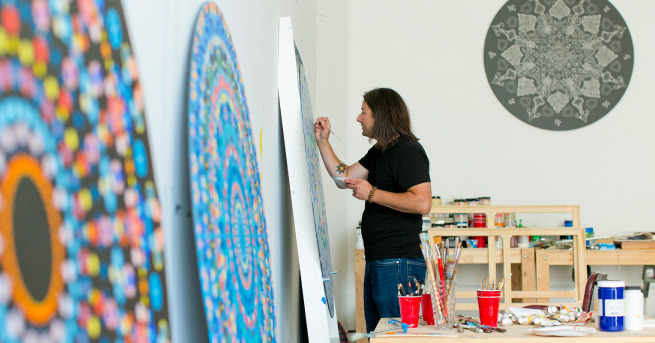CACHE IS NOT AT THE ABOVE COORDINATES It is at N44°AB.CDE W88°FG.HIJ
Inspired by recent conversations with some of my artist friends, I decided to explore the valley a bit and share with you some of the places where each of them have left an impact on the physical and metaphysical landscape of the Valley. The Artisans of Appleton series will reveal to you just how much our cherished Fox Valley artists have contributed to the arts and culture of this place. It should make you proud call the Valley your home.

Tony Conrad received his MFA degree in painting and drawing from the University of Wisconsin-Milwaukee in 2009 and is now a Visiting Assistant Professor of Art at Lawrence University. Tony’s work has been exhibited in various solo, group, and invitational exhibitions and has won a number of awards including the Lawrence Rathsack Scholarship and the Frederick R. Layton Fellowship. Recently, his paintings have been exhibited at the Museum of Wisconsin Art, as well as the Madison Museum of Contemporary Art.
The first thing that grabs you about Tony Conrad’s works shown at MMoCA is his meticulous recreation of traditional Persian patterning. In their symmetry, arabesque embellishments and vibrant colors, his paintings epitomize the delicate beauty of these woven textiles. Collaged into the composition, however, are images of bullets and round case heads scanned from photographs and printed on thin paper. Iconic symbols of masculinity, which Tony remembers from growing up in rural Wisconsin—trophy stags, hunter silhouettes, and ammunition—are deftly combined with densely layered Persian design of domesticity. Ballistic Blossom presents a central focal point of casings, half the number of casings in Ballistic Burst's inner ring of AC. Shotgun Pattern's #J and #H's centers are anchored with just I shell heads, while Swirling Shells has a dense cluster of DF at dead center and only G and the outside corners.
More recently Tony has shown, and is now represented by, Frank Jaurez Galley of Milwaukee. In is newer work, Tony is challenging his viewer to dive deeper into his multi-layered textures of cross-hatched mayhem which can initially avert a viewer's gaze. He is intentionally asking you to stop and engage with the art, picking up on the subtleties and not simply walk by. The obvious double diamond of Composition #F quickly melts as you get close and engage the work. The same holds for Composition #E whose concentric pinks add blue squares hover just above the rich plaid pattern below, in imminent danger of being absorbed by it altogether.
"My work has influences from various cultural and historical movements including Persian textiles, Tibetan Buddhism, psychedelic rock culture, and meditative states. I’m particularly drawn to the beautiful patterning that is central to these traditions. The mandala has always been a powerful symbol of peace and empathy and in the case of Buddhism, has historically been used to establish a sacred space, a space for meditation."
Conrad came up with the idea for the Appleton Mandala Project in 2015 in an effort to to help make downtown Appleton more visually engaging. Drawing not only on Middle and Far Eastern traditions but also on the grand notion of initiating an evolving public art project that would embrace and entice other local artists to could contribute their own mandalas over time. This collaborative public art approach is something Conrad witnessed in the Barn Quilt trail project that has grown in a relatively short period of time from a handful of 20 installed in Adams County, Ohio in 2001 to quite likely the largest collaborative public art project of its kind in the nation. After the first year local quilt guilds, arts councils, school groups, and other organizations joined in the decentralized concept and begin adding to the project at will. Today it's almost impossible to drive down a rural country road and not see a quilt painting on the side of a barn or outbuilding.
"I love this idea of a community coming together to create a visual landscape that is thought provoking and simply beautiful." Conrad hopes that other local artists will take the initiative and find their own passion for the project and begin to grow the public art participation of mandala makers, adding the first set of B and growing to become a huge ad hoc collection of artisans of Appleton mandalas.